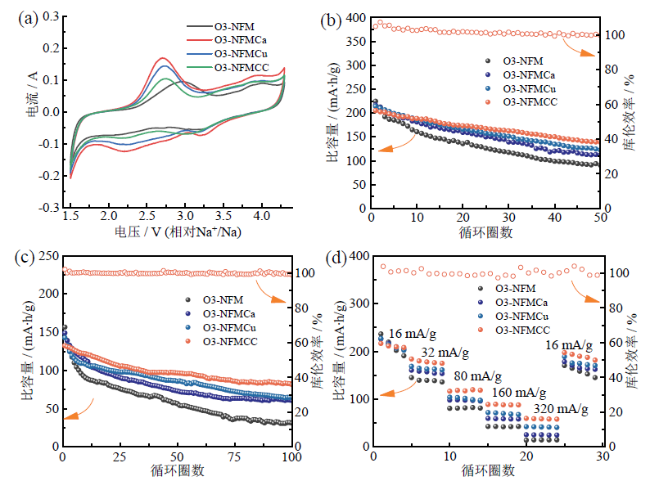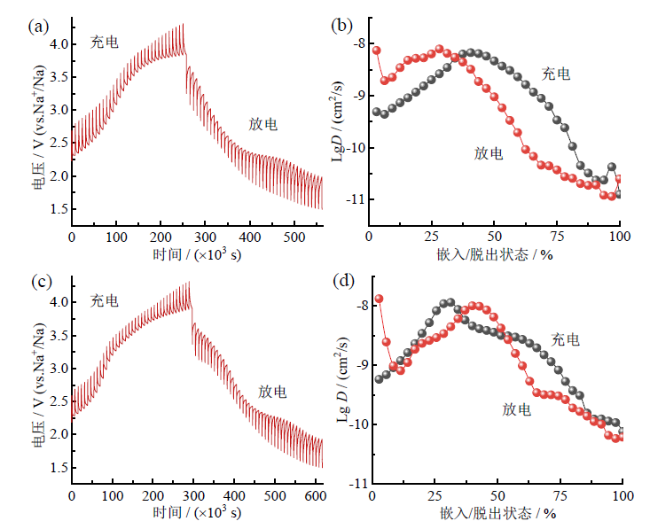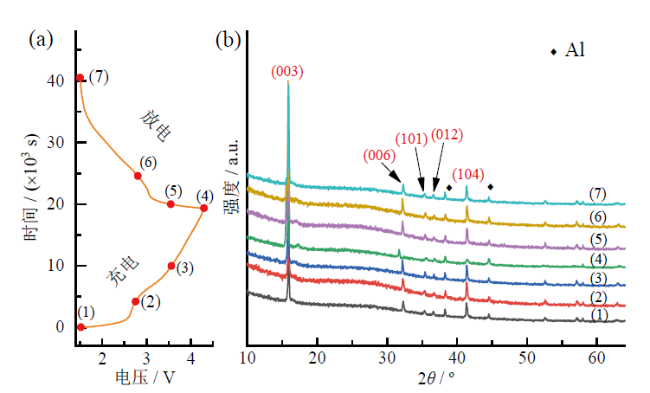0 引言
1 实验部分
1.1 材料合成
1.2 物相与形貌表征
1.3 电化学性能表征
2 结果与讨论
Fig. 1 (a) XRD diffraction of O3-NFM, O3-NFMCa, O3-NFMCu and O3-NFMCC; (b) XPS pattern of Mn; XPS spectrum analysis of Mn 2p in O3-NFM (c) and O3-NFMCC (d)图1 (a)O3-NFM、O3-NFMCa、O3-NFMCu和O3-NFMCC的XRD图;(b)Mn的XPS图谱;O3-NFM(c)和O3-NFMCC(d)中Mn 2p的XPS图谱分析 |
Fig. 2 (a-d) SEM images of O3-NFM, O3-NFMCa, O3-NFMCu and O3-NFMCC; (e) high-resolution TEM images of O3-NFMCC; TEM image (f) and EDS elements mapping (g-l) of O3-NFMCC图2 (a ~ d)O3-NFM、O3-NFMCa、O3-NFMCu和O3-NFMCC的SEM图;(e)O3-NFMCC的高分辨透射电镜图;O3-NFMCC的TEM图像(f)和EDS元素分布图(g ~ l) |
Fig. 3 Electrochemical performance of the O3-NFM, O3-NFMCa, O3-NFMCu and O3-NFMCC electrode: (a) CV curves at 0.1 mV/s; cycling performances at 32 mA/g(b) and 160 mA/g (c); (d) rate performances at diverse current densities from 16 mA/g to 320 mA/g图3 O3-NFM、O3-NFMCa、O3-NFMCu和O3-NFMCC电极的电化学性能:(a)0.1 mV/s下的CV曲线图;32 mA/g(b)和160 mA/g(c)下的循环性能图;(d)16 ~ 320 mA/g下的倍率性能图 |
Fig. 4 The GITT image of O3-NFM (a) and the computed diffusivity of Na+ at charge-discharge processes (b); the GITT image of O3-NFMCC (c) and the computed diffusivity of Na+ at charge-discharge processes (d)图4 O3-NFM的GITT图(a)和Na+ 在嵌入/脱出状态下的扩散速率(b);O3-NFMCC的GITT图(c)和Na+ 在嵌入/脱出状态下的扩散速率(d) |
Fig. 5 The ex-situ XRD cut-off potential point (a) and the corresponding XRD patterns (b) of O3-NFMCC图5 O3-NFMCC的非原位XRD截止电位点(a)及其相应的XRD图谱(b) |









